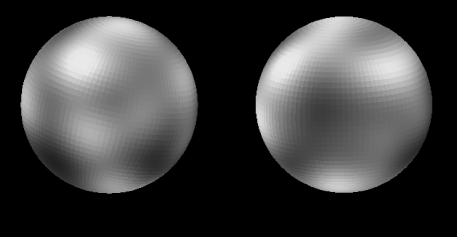Astronomy Picture of the Day
Discover the cosmos!
Each day a different image or photograph of our fascinating universe is
featured, along with a brief explanation written by a professional
astronomer.
March 11, 1996

Hubble Telescope Maps Pluto
Credit:
A. Stern
(SwRI),
M. Buie
(Lowell Observatory),
NASA,
ESA,
Explanation:
No spacecraft from Earth has yet explored Pluto
but astronomers have found ways of
mapping its surface.
A stunning map of
this distant, diminutive planet, the first based on
direct images, was revealed late last week in a
Hubble Space Telescope press release.
Above are two opposite hemisphere views of
the computer constructed
map of Pluto's surface (north is up).
The grid pattern is due to the computer technique used
where each grid element is over 100 miles across.
The map is based on Hubble images made when
Pluto was a mere 3 billion miles distant.
It shows strong brightness variations -
confirming and substantially improving upon
ground based observations.
While the brightness variations may be due to surface features like craters
and basins they are more likely caused by regions of nitrogen
and methane frost.
The frost regions should show "seasonal" changes which can be
tracked in future Hubble observations.
Yes, Pluto is a planet
even though it is only 2/3 the size of Earth's Moon!
Information:
The
Scale of the Universe Debate in April 1996
Tomorrow's picture: The Colorful Clouds of Rho Ophiuchi
| Archive
| Index
| Search
| Glossary
| Education
| About APOD |




Authors & editors:
Robert Nemiroff
(GMU) &
Jerry
Bonnell (USRA).
NASA Technical Rep.:
Sherri
Calvo.
Specific rights apply.
A service of:
LHEA
at
NASA/
GSFC




